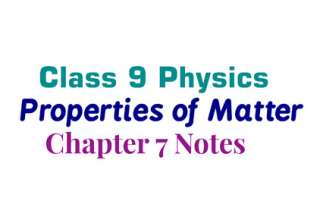Physics 9th Class Chapter 3 Notes are here. This post contains Solved Numerical and Short Question of 3rd Chapter of 9th Class Physics. This chapter is presented here for students of Class 9 who are looking online for the notes of Physics. There are some numericals and some short questions, all are solved.
Solved Numerical and Short Questions of Dynamics Chapter – Physics 9th Class Chapter 3 Notes
You may also like: Short Questions of Chapter 2 – Short Questions of Chapter 4
Q.1: Write two methods to reduce friction.
Ans. Friction can be reduced by:
- Making sliding surface moth.
- Lubricating the sliding surface.
Q.2: A force of 20N moves a body with an acceleration of 2mS-¹. What is its mass?
Ans.
F = 20N
a = 2mS-¹
m = ?
Formula F = ma
m = F/a = 20/2
m = 10 kg
Q.3: Why rolling friction is less than sliding friction?
Ans. The interlocking between ups and downs of the two surfaces need not be ruptured, in case of rolling while in case of sliding these are to be ruptured and results larger force of friction.
Q.4: The weight of a body is 147N. What is its mass?
Ans.
W = 147N m=?
Formula W = mg
m = W/g
m = 147/10
m = 14.7 Kg
Q.5: Define Law of Inertia.
Ans. The inertia of a body is its property due to which it resists any change in its state of rest or motion.
Q.6: Define momentum and write the formula.
Ans. The momentum of a body is the quantity of motion it possesses due to its mass and velocity.
Formula = P = mv
Q.7 :Defien centrifugal force.
Ans. According to Newton’s third law of motion, there exists a reaction to the centripetal force. The centripetal reaction that pulls the string outward is sometimes called the centrifugal force.
Q.8: Give two differences between mass and weight.
Ans.
Mass:
- Mass of a body is the quantity of matter possessed by the body.
- Mass is a scalar quantity.
Weight:
- The weight of a body is the force of gravity acting on it.
- It is a vector quantity.
Q.9: Define momentum and write its unit.
Ans. The momentum of a body is the quantity of motion it possesses due to its mass and velocity.
Unit: Its SI unit is Kgms-¹
Q.10: Differentiate between mass and weight.
Ans.
Mass: Mass of a body is the quantity of matter possessed by the body.
Weight: Weight of a body is the force of gravity acting on it.
Q.11: Define Newton’s second law of motion and give equation.
Ans. When a net force acts on a body, it produces acceleration in the body in the direction of the net force. The magnitude of this acceleration is directly proportional to the net force acting on the body and inversely proportional to its mass.
Equation: F = m a
Q. 12: Define centripetal force and write its mathematical form.
Ans. Centripetal force is a force that keeps a body to move in a circle.
Mathematical form: Fc = mv²/r
Q.13: What is the difference between action and reaction?
Ans.
Action: Action is always accompanied by a reaction force and the two forces must always be equal and opposite.
Reaction: To every action, there is always an equal but opposite reaction.
Q.14: Write two disadvantages of friction.
Ans.
- Friction causes wear and tear of the moving parts of machines.
- Most of the useful energy is lost due to friction
Q.15: Define force and write its SI unit.
Ans. A force moves or tends to move stops or tends to stop the motion of a body. The force can also chane the direction of motion of a body.
Unit: Its SI unit Newton (N)
Q.16: Find the acceleration produced by a force of 100 N in a mass of 50kg.
Ans.
F = 100 N, m=50Kg
Formula: F=ma
a=F/m = 100/50 = 2mS-²
Q.17: State Newton’s third law of motion and give an example.
Ans. To every action, there is always an equal but opposite reaction.
Example: Interaction Forces Pairs.
Q.18: What is meant by co-efficient of friction? Write its symbol.
Ans. The ratio between the force of limiting friction Fs and the normal reaction R is constant. This constant is called the coefficient of friction.
Symbol: µ
Q.19: What is meant by dynamics?
Ans. The branch of mechanics that deals with the study of the motion of an object and the causes of its motion is called dynamics.
Q.20: What is meant by rolling friction?
Ans. Rolling friction is the force of friction between a rolling body and a surface over which its rolls.
Solved MCQs of Physics Chapter 3 for Class 9 are also available.
Above available Short Questions are taken from Al-Hassan Super Notes Physics (English Medium) – IX






Raza
June 26, 2020 at 11:32 am
very nice. Your question & answers are amazing. love this site.
Jannat
June 26, 2020 at 11:34 am
yes u are right